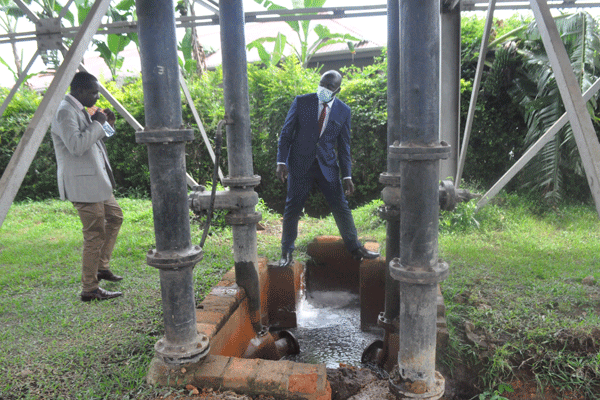Prime
Water ATM brings hope to urban poor

Residents fetch water at the ATM in Kisaasi, Kawempe Division, in Kampala City. PHOTO/ GILLIAN NANTUME
What you need to know:
- To get water flowing from the machine, one has to insert a legal coin into the slot and press the start button.
Availability of clean water for citizens is one of the hallmarks of development in any country.
While there are a number of community water taps in the Kampala suburbs, their affordability depends on the supply from National Water and Sewerage Corporation (NWSC).
In some locales, to fetch a 20-litre jerrycan of water from a community tap, one has to part with between Shs300 and Shs500.
Now, Joel Makadesh Mukisa, an innovator, has made and installed a water ATM machine for the urban poor in Kisaasi, Kawempe Division, in Kampala City.
The machine has a slot and three buttons. To get water flowing from the machine, one has to insert a legal coin into the slot, and then, press the start button. The other control buttons are a ‘pause button’ and a ‘stop button’.
Mukisa, who is also the founder of Joelex Uganda Limited, says this machine will help people who sell water to the community to have accountability for their proceeds.
“Many young local entrepreneurs have water taps, but if you do some research, they also face the same problem. They leave their employees to manage the taps but they have no way to account for the money they get from selling water. We have now been in operation in Kisaasi for nine months. We chose this place because we realised the number of (community) taps available were not enough for the population,” Mukisa says.
Community taps in the area charge Shs300 per 20-litre jerrycan. However, the water ATM charges Shs200 per 20-litre jerrycan and Shs100 for a 10-litre jerrycan.
Anne Namukwaya, who owns a laundry business, says because of her physical disability, the tap is a blessing to her.
“The tap is near my home and the amount charged for the water is fair, compared to other taps. I use a lot of water in my work. In a day, I use between 12 to 15 jerrycans every day, and at Shs200 each, I save between Shs1,200 and Shs1,300.,” she says.
Source of water
The tap is supplied by two water tanks installed nearby - containing 2,000 litres of water. Henry Kiberu, a resident, says the advantage of the water ATM is that it can be operated at any time, since it does not need a minder.
“Even if you leave work late, you do not have to worry about returning to a house with no water. Even if you want to take a bath at 3am, all you have to do is insert the coin and the water will flow into your jerrycan,” he says.
Mukisa rents the space at Shs180,000 per month. The business has already broken even, and he does not incur expenses in hiring a caretaker.
“Depending on the number of people who access the facility, every four to seven days, we make an average of between Shs180,000 and Shs300,000. One of the challenges we face is that some people are not honest, and they try to improvise by inserting bottle tops into the slot or any other metallic coin, instead of a legal coin.
However, when that happens, the slot rejects the bottle tops and the system automatically freezes. This brings shortfalls in water provision” Mukisa says.
The main challenge faced by the water ATM is low pressure from the NWSC supply.
Mukisa appeals to the government to take up the water ATM system to meet its target of availing clean and safe water to the urban poor, in an age where sanitation and hygiene are key for everyday life.





